
7 minute read
Suffolk birds - more winners & losers ........................Mick Wright
The declines and increases of a few Suffolk Birds
Editor: Mick Wright continues to delve into the Bird Atlas data to provide us with further insights into the ‘State of Nature’ of Suffolk’s birds.
Following on from my last report in the Harrier 171, here are a few more examples of species that are either declining or increasing.
Losers
Ringed Plover (Charadrius hiaticula)
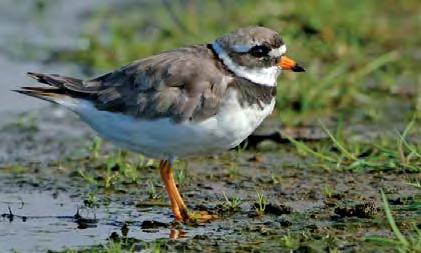
The ongoing decline of the Ringed Plover has been documented by the Suffolk Ornithologists’ Group (SOG) members, which have, in the past, monitored this species, and by the national surveys organised by the British Trust for Ornithology (BTO) in 1984 and in 2007. In the main breeding areas in 1984, Ray Waters (1985) concluded that at our largest Ringed Plover colonies, space is becoming limited due to the increased number of human visitors, causing a decline in numbers. In 2007 a comprehensive search of all coastline and suitable estuarine habitat for breeding Ringed Plover found only 43 pairs at 22 locations. Of these 70% (thirty pairs) were found at just five sites, which were the Orwell estuary, Orford Ness, Landguard, Erwarton (River Stour) and Minsmere. All pairs were found breeding on coastal or estuarine sand/shingle habitats, none were found inland on heathland or agricultural sites (Wright 2007). The 2007-11 Atlas of breeding Ringed Plovers, carried out over a four-year period, when compared to the previous Atlas of 1988-91 clearly indicates their ongoing decline. Ringed Plovers require a distinctive habitat of coastal sand and shingle beaches, or sandy shell substrates above the high water mark, often just behind old tidelines, which are associated with our estuaries. It is without question that their breeding habitats are under intense pressure from our leisure activities.
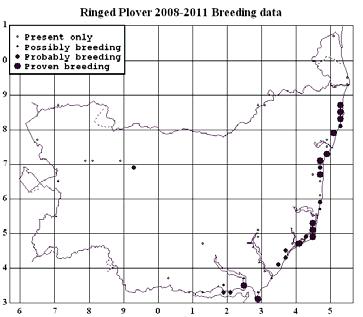
The Ringed Plover is now on the Birds of Conservation Concern (BoCC) Amber list, however, for Suffolk it ought to be Red listed. The 2007 national survey found that there has been a catastrophic decline in the number of breeding Ringed Plovers in Suffolk of around 77% when compared to the figures from the last major survey in 1984. To my knowledge, nowhere along the Suffolk coast or the shorelines of our estuaries, have areas been designated for these ground-nesting birds to breed. If we are to have Ringed Plovers breeding on our beaches, in the future, then targeted action is required.
Ringed Plover 2008-2011 breeding data

Meadow Pipit (Anthus pratensis) The Meadow Pipit is an Amber listed species. According to the Common Bird Census/Breeding Bird Survey (CBC/BBS) the trend has been downward since the mid 1970s, with a moderate population decline of 25-50%. This decline is also accompanied by a range contraction from lowland England (BTO). It is primarily a bird of open habitat, despite being present in fewer numbers in Suffolk, it can still be found on rough grassland, saltmarsh and uncultivated and low-intensity farmland areas. The breeding population is now mainly coastal, especially between East Lane and Southwold. Concentrations occur along the Waveney Valley and around Halesworth and in Breckland, otherwise it is sporadic elsewhere. The map showing the results from the 2008-2011 Atlas period when compared to the map for the 1989-1992 Atlas period indicates that breeding numbers and the distribution have decreased still further.
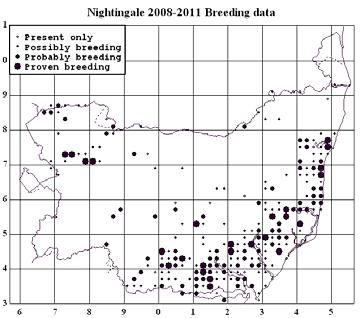
Meadow Pipit 2008-2011 breeding data
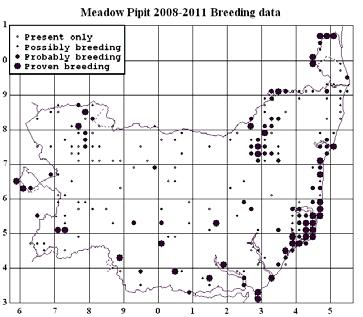
6 Nightingale (Luscinia megarhynchos) Within Britain, the distribution of Nightingales has always been restricted to the southeast. Atlas data since the 1960s has shown a clear contraction of breeding range away from the western and northern limits. Census data also shows that numbers have declined strongly in recent decades. The BBS indicates that, between 1995 and 2009, the British Nightingale population decreased by 57%.
Nightingale 2008-2011 breeding data
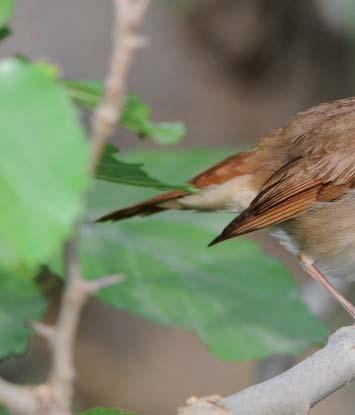
One possible explanation for the decline is that habitat suitable for Nightingales in which to breed is becoming scarcer. Nightingales require impenetrable bushes, thickets and thick hedgerows in which to build and hide their nests. Throughout the county, scrub, in just about all its forms, is overlooked or actively disparaged as a habitat; in fact there’s a tendency to clear scrub and do very little to maintain and extend it. Scrub is such an important habitat for a wide range of fauna. Also, as Nightingales are longdistance migrants, wintering in West Africa, with the extension of the Sahara they might be encountering added barriers to successful migration. The results from the 2008-2011 Atlas period show a dramatic concentration in the south-east and a clear change in distribution when compared with the 1989-1992 Atlas period. With regard to changes in population size, more analysis of the Atlas data needs to be carried out, although the distribution map suggests a healthy population. A BTO national Nightingale survey was undertaken in 2012-2013, the results of which are eagerly awaited.
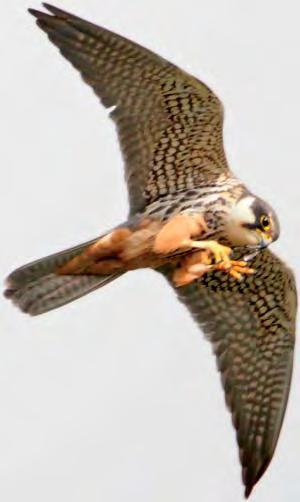
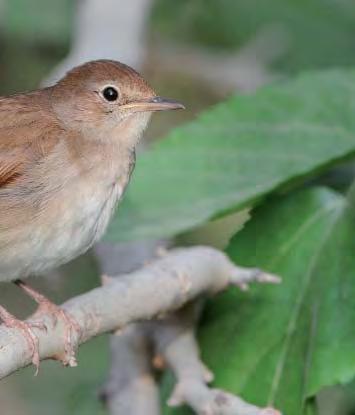
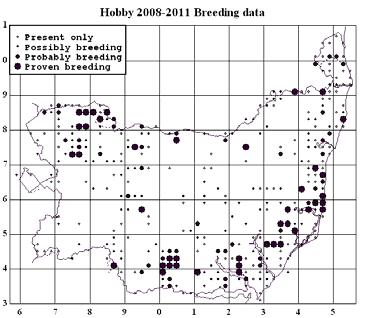
Winners
Hobby (Falco subbuteo) Since 1830, when the first nest was reported at Stoke-by-Nayland (Babington 1884-1886), it appears that the Hobby bred sporadically up until the mid-1970s (Piotrowski 2003). It is clear from Suffolk Bird reports and SOG bulletins that, during the 1980s and 1990s, summer records of Hobby’s being seen in suitable breeding habitat increased considerably. In 1987 eight pairs were considered breeding in the county and in 1991 there was a minimum of 15 territories. Following the breeding raptor and owl survey carried out by SOG over the period 1995- 1998, Wright (2001) stated that the breeding status for Hobby was increasing but is variable between years and estimated the breeding population to be 15 – 25 pairs. The map showing the results from the 2008-2011 Atlas period indicates that breeding numbers are still on the increase with breeding being proven in 40 tetrads.
Hobby 2008-2011 breeding data

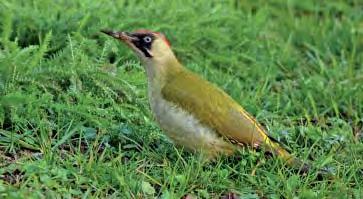

Green Woodpecker (Picus viridis) The Green Woodpecker is a resident species, sedentary and site faithful to breeding areas. This species prefers deciduous woodlands yet can be found in parkland and farmland but, as it spends most of its time on the ground feeding predominantly on ants, these birds also require grassland and open scrub areas where ants are plentiful.
Green Woodpecker winter data
According to Bird Trends (BTO) the Green Woodpecker, 8 nationally, has doubled its population size over the last 40 years. However, in the past, populations have declined due to widespread loss of woodland and to the intensification of farming methods. Numbers also fluctuate owing to severe winters. Over the last forty years there has been a northward spread of this species. In Suffolk, the Green Woodpecker was found in almost every tetrad during the winter Atlas period of 2008 – 2011 indicating the sedentary nature of this species. When comparing the 2008-2009 breeding data with that from the 1989-1992 Atlas period, the distribution is far more comprehensive with Green Woodpeckers being seen in many more tetrads. There are however, a lot of ‘seen only’ dots on the map, which may mean that birds are flying further from their breeding site to find feeding areas.
Green Woodpecker breeding data Reed Bunting (Emberiza schoeniclus) The Reed Bunting is a BoCC Amber listed species and a Suffolk Biodiversity Action Plan (BAP) species. The UK population of reed bunting fell by 54% between 1970 and 1998 (BTO). The drainage of our wetlands, reduction in damp habitats and food sources and changes in agricultural practices have all had a detrimental effect on this species. In recent years, however, results from BBS suggest a significant population increase, with figures between 1994-96 and 2007-09 indicating that the increase has been widespread. When comparing the 2008-2009 breeding data with that from the 1989-1992 Atlas period, the distribution appears to be stable in some areas and declining in other areas, especially in the Shotley peninsula, Hollesley and some areas in the southwest.
Reed Bunting 2008-2011 breeding data
References [BTO] Data source: British Trust for Ornithology Piotrowski S. 2003 The Birds of Suffolk, C Helm SBRs Suffolk Bird reports. Published by The Suffolk Naturalists’ Society Waters, R (1985) BTO Breeding Ringed Plover Survey 1984, Suffolk Ornithologists’ Group Summer Bulletin 1985 pp.12-18. Wright M. 2001 Survey of Breeding Raptors & Owls in Suffolk 19951998, Published by The Suffolk Ornithologists’ Group








